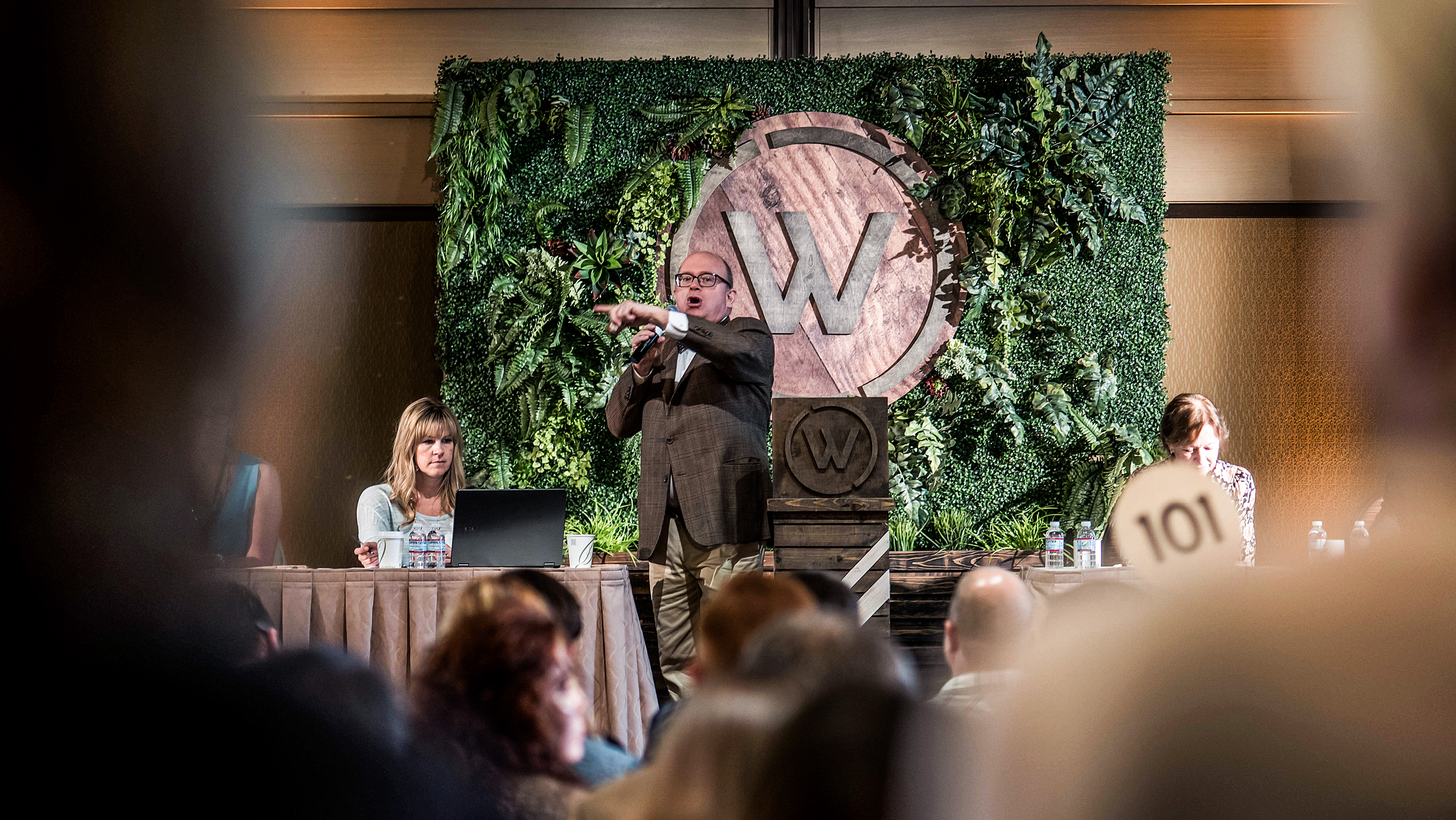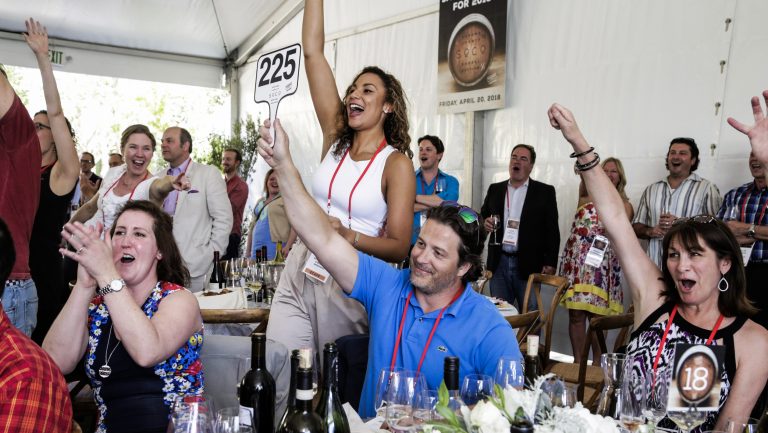First the list full of rare futures pings its way across the Web. Then come the spreadsheets, the hobnobbing with winemakers, the late nights in vineyards, followed by early mornings spent sipping and spitting. Finally there’s the jockeying, the paddle waving—and the breathtaking moment when a coveted lot that was just within a buyer’s reach gets yanked out from beneath her in a last-minute steal.
Welcome to the rising trend in the wine auction world: trade-exclusive barrel auctions, hosted by representatives from a handful of regions and designed to put one-of-a-kind wines on restaurant lists and in retail shops. With auction events heating up this spring, wine professionals share with SevenFifty Daily’s readers why they attend, what prompts them to snag a deal, and how they make the most of their time.
Using a Wine Auction to Corner the Market
At present, there are four major trade-only auctions in the United States: Reveal Walla Walla, Sonoma County Barrel Auction, Willamette: The Pinot Noir Auction, and Premiere Napa Valley. All are designed to give buyers access to one-of-a-kind lots. In some cases, this means reserves set aside or wines made exclusively for the auction; in other cases, the wines might be a blend of single-variety estate fruit from three winemakers. For example, at the upcoming Reveal Walla Walla (where each year is dedicated to a single vintage), there’s a 2016 Cayuse Vineyards Syrah, blended from several different vineyards which will be bottled in magnum. At the 2017 Sonoma County Barrel Auction (SoCo), winemakers Matt Courtney, Mike Sullivan, and Bob Cabral—of Arista Winery, Benovia Winery, and Three Sticks Wines, respectively—assembled a Pinot Noir using select Calera clones from a vineyard at each winery, combined with Swan clones from vineyards at each.

Don’t miss the latest drinks industry news and insights. Sign up for our award-winning newsletters and get insider intel, resources, and trends delivered to your inbox every week.
Because lots at each auction will typically be 5, 10, or 20 cases, and because these wines are not otherwise built into a winery’s program, bid-winning restaurants and retailers get a chance to corner a market for their customers.
“I think it’s really fun for either a retailer or a restaurateur to grab a lot of something that doesn’t really exist in the marketplace,” says Doug Frost, MS, MW, who consults on United Airlines’ wine and spirits program. “It’s interesting for customers; it’s interesting for staff. It’s a fun way to draw attention to what you’re doing—and that you’re not just buying what shows up in somebody’s catalog, but you’re actually going out there and trying to create something.” It allows you to build a unique angle into a list, or develop an offering no one else can.
Exclusivity is key for retailers like David Marberger, the owner of Bay Ridge Wine and Spirits in Maryland, who says his customers love the kind of never-before, never-again opportunities he brings back from auctions. “Whatever the total number of cases produced is, it’s all of that wine that will ever be made,” Marberger says. “And that’s really a big feather in a collector’s or big wine consumer’s cap—to be able to say, ‘Hey, come on over. Let’s do a real nice dinner at my house … and I’m going to serve you wine that you’ve never had before and you’ll never get again.’”
Achieving Your Goals
For Robert Merrifield, the proprietor and chef of Tulsa’s Polo Grill, buying lots at auction serves another very distinct purpose: It helps him get his hands on wines not otherwise distributed in his home state of Oklahoma. Much of the wine at these auctions comes from boutique wineries, many of which aren’t widely distributed to smaller markets.
Granted, auctions are Merrifield’s thing. He’s been attending them since 1999 and now regularly goes to Reveal Walla Walla, SoCo, and the Willamette auction. His commitment derives from a very specific program: He has a cellar dedicated exclusively to auction wines. Today his collection includes 147 different labels from Premiere Napa Valley, and coming soon are the 11 lots he purchased at the first Reveal Walla Walla and the 18 lots he won at last year’s SoCo.
Merrifield views auctions as a source of discovery. Not only did he land lots of Leonetti and L’Ecole at his first Reveal Walla Walla, but he won lots from wineries he’d never heard of before, including a blend made by Amavi and students from Walla Walla Community College’s Institute for Enology and Viticulture program. He plans to use that wine in a forthcoming dinner featuring the cooking of students from Oklahoma State University’s culinary program.
More Than Just a Party
It’s the discoveries, say insiders, that matter most at barrel auctions, and they can often be found in the days leading up to the actual bidding. Each auction includes events beforehand that are targeted specifically to the trade. The oldest auction, Premiere Napa Valley, is known for its pre-event, invite-only ragers; Reveal Walla Walla’s first year featured a pig roast, which has since evolved into a dinner and library tasting event.
Regardless of how the hosts throw down, though, each region typically uses the days before the auction to offer vertical tastings and sub-AVA horizontals and to educate industry buyers on everything from soil type to vintage variation. Jeff Degner, a beverage consultant with Eastern Retail Services, a beverage business consulting company based in San Antonio, Texas, has so far attended Premiere Napa Valley four times, and the Willamette Pinot auction and its seminars twice. “You can really learn more about these wines,” he says, “when tasting them side by side—and get a better perspective of vintages or soil types, particularly in Oregon.”
Attendees also use the time to gather industry intel. “It’s great to go out and spend time with winemakers and winery representatives [and to] get a feel for what’s going on out in the market,” says Marberger. “Not just from a ‘How can you help us?’ perspective, but also to see, overall, what other people are doing, what they’re investigating.”

Getting the Jump on Wine Auction Deals
Not only do buyers get exclusivity at barrel auctions but they also often get a unique wine at a lower cost than what it might have been had the wine made its way through the traditional distribution system. While there are steals to be had across the board at most of the auctions, the best deals are often found in the first couple of years after an auction arrives on the scene. “We went thinking we might be able to sneak some goodies out of there, and sure enough, we were able to,” says Merrifield of the first Reveal Walla Walla. “I can assure you, we saw prices almost double in the second year of SoCo.” The restaurateur says he expects prices at Walla Walla and Willamette to also rise in the coming years as more people learn about the auctions. Eastern Retail Services’s Degner admits that while he still often attends Premiere Napa Valley for the experience, when it comes to buying, he has pretty much been priced out of the competition by the hordes of big-box stores—with their deeper pockets—that are now attending.
Marberger parlayed the first SoCo into deals for his customers. “We were lucky enough to be there the first year,” he says, “and we got some unbelievable wine for some pretty inexpensive prices. That was really a great thing for us—to come back and share those wines with our customers at a price point that was not astronomical. It wasn’t anything like Premiere Napa Valley, where the auction prices are easily mid-three-digit numbers.”
While prices at the auctions have risen, they’re still approachable, especially when it comes to bang for the buck. “The quality of the wine coming out of Sonoma is phenomenal,” says Marberger. “To equate that back to an auction bottle that we can get in here to the store, and still offer to our customers at, quite honestly, a reachable retail price for them is very important to us.”
Landing those deals takes a plan—a budget and a bucket list of wines or winemakers you’d really like to acquire, for example—and those plans often fall apart during the research and bidding. Marberger may spend the days leading up to an auction meeting with winemakers, tasting wines made in a similar style or from a similar vintage to what is in barrel for the auction, and making a plan, only to have his focus shift when, during pre-auction barrel tasting, he stumbles on a hidden gem—like a small-production wine he wouldn’t otherwise have considered. Suddenly, his agenda to acquire the entire lot of one wine could be jettisoned in exchange for something completely unexpected.
When it comes to the actual paddle-raising moment, Marberger advises that you practice your best poker face. He can’t count the number of times he’s swooped in and stolen a lot from someone else—and how often it’s happened to him. And, he warns, it’s hard to let a wine go by that you really wanted, once it has exceeded your price.
Which is why, besides suggesting that you attend auctions early in their life cycle, Frost recommends that you not wait for the last lot. “Bid early,” he says. “It starts slow. Things heat up as the auction goes along.”

Dispatch
Sign up for our award-winning newsletter
Don’t miss the latest drinks industry news and insights—delivered to your inbox every week.
When she’s not writing about beverage, travel, or weird science, Julie H. Case can be found deep in America’s forests, foraging for mushrooms.






